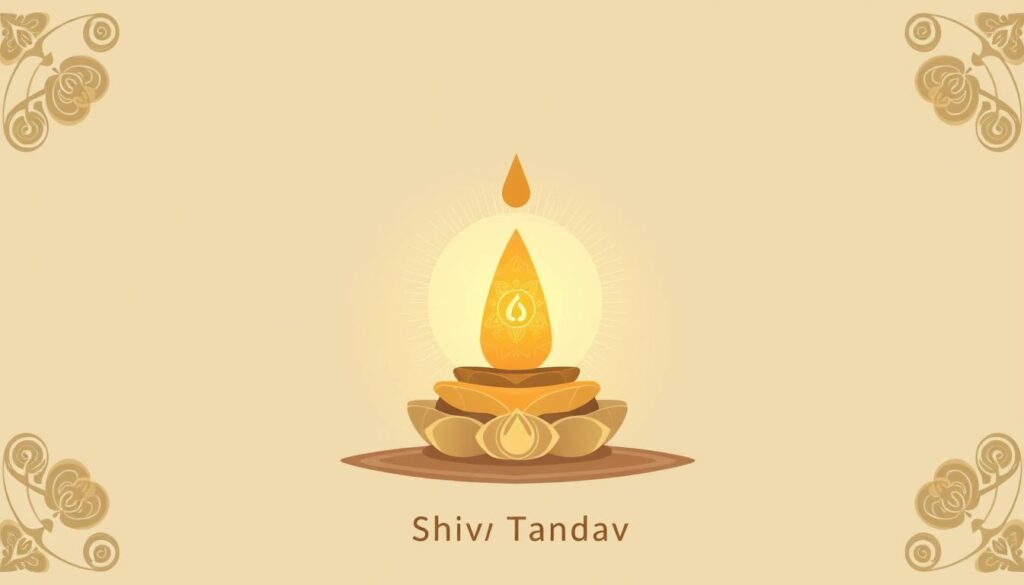
Shiva, the mighty Lord of the Hindu pantheon, is known by many names in ancient Sanskrit texts. He has over 1,000 distinct titles. This shows the vast and intricate nature of his full name.
He is revered as the Destroyer in the Trimurti. Shiva’s influence reaches across the Indian subcontinent and Southeast Asia. His enigmatic persona and cosmic powers captivate many devotees.
Key Takeaways
- Shiva is one of the principal deities in Hinduism, part of the Trimurti with Brahma and Vishnu.
- He is known by numerous names and epithets in Sanskrit literature, reflecting his diverse aspects and roles.
- Shiva’s iconographic attributes include the serpent Vasuki, crescent moon, river Ganga, third eye, trishula, and damaru.
- The word “Shiva” means “auspicious, propitious, gracious, benign, kind, benevolent, friendly.”
- Shiva is revered widely by Hindus in India, Nepal, Bangladesh, Sri Lanka, and Indonesia.
Understanding Lord Shiva’s Divine Identity
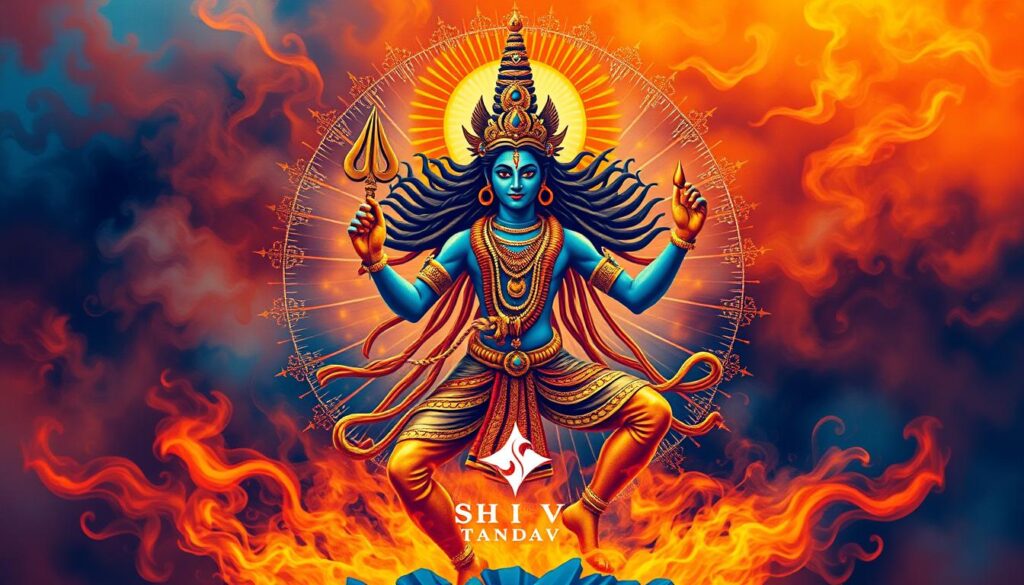
Lord Shiva is a key figure in Hinduism, known as the Supreme Being in the Hindu Trinity. He is seen as the “Destroyer” in the Trimurti. This role is vital in the cycle of creation, preservation, and transformation of the universe.
The Supreme Being in Hindu Trinity
In Hinduism, Shiva is one of the three main deities. He is alongside Brahma, the Creator, and Vishnu, the Preserver. Together, they form the Trimurti, showing the divine cosmic order.
Role as Creator, Preserver, and Destroyer
Shiva’s role is complete, covering all aspects of existence. As the Destroyer, he dissolves and transforms the material world. This makes way for new creation, showing the universe’s eternal cycle.
Historical Evolution of Shiva Worship
Shiva worship started in pre-Vedic tribal traditions and later became part of the Vedic pantheon. Shiva is a mix of various deities, both Vedic and non-Vedic. His identity evolved from Rudra to Mahadeva, showing Hindu spirituality’s dynamic and inclusive nature.
“Shiva” means “that which is not”, emphasizing the concept of nothingness which is the basis of existence.
Modern science also talks about vast nothingness, called Shiva in ancient Sanskrit texts. It’s seen as the cosmic womb where everything is born and dissolves back into.
Etymology and Origins of Shiva’s Name
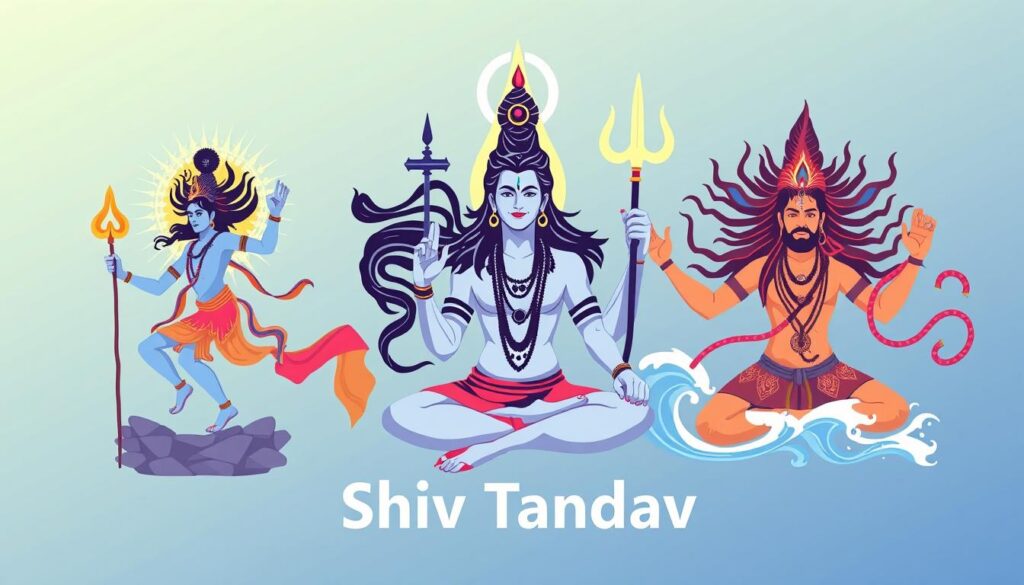
The name of Lord Shiva comes from ancient Sanskrit. “Śiva” means “auspicious,” “propitious,” and “gracious.” It shows the deep meaning behind this revered Hindu deity.
The roots of “śiva” are śī and va. Śī means everything is connected, and va means grace. So, Shiva’s name means a divine being that is all-pervading and gracious.
Over time, “Shiva” changed from “Rudra-Shiva” in the Vedas to just “Shiva” in the Epics and Puranas. This change shows how Shiva evolved from a scary Vedic god to a kind and powerful supreme god. He is seen as the creator, preserver, and destroyer of the universe.
| Meanings of Shiva’s Name | Attributes of Lord Shiva |
|---|---|
| Auspicious, Propitious, Gracious | Benevolent, Kind, Friendly |
| All-Pervasive, Embodiment of Grace | Creator, Preserver, Dissolver |
The name change from “Rudra-Shiva” to “Shiva” shows Shiva’s transformation. He went from being a scary god to a kind and gracious one. Now, he is the most respected god in Hinduism.
The Full Name of Lord Shiva: Sacred Sanskrit Origins
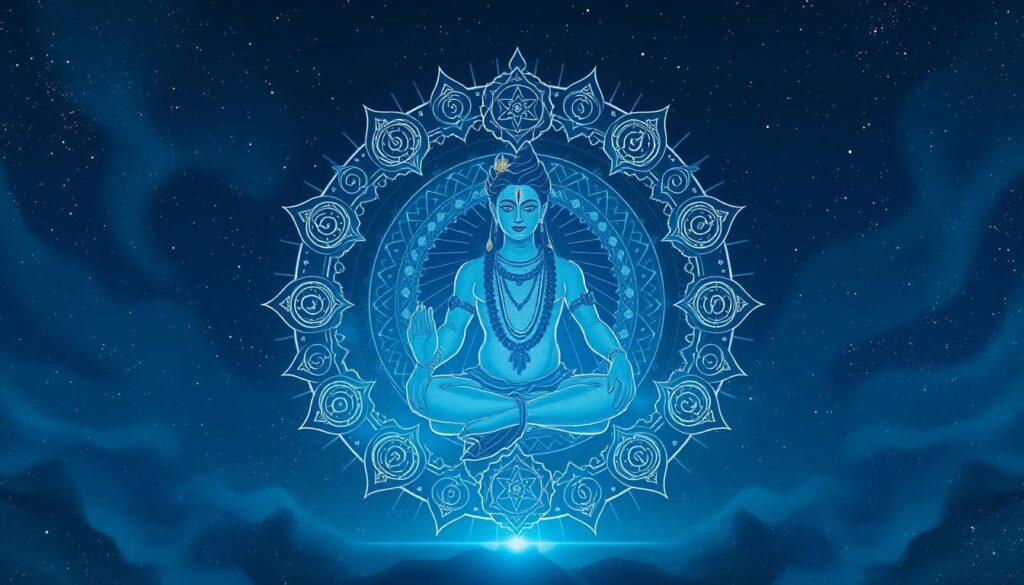
Exploring Lord Shiva’s divine identity, we find deep meaning in his many names. His full name shows a wide range of qualities. Each one highlights a different side of his nature.
Sanskrit Root Words and Their Meanings
The core of Shiva’s name comes from Sanskrit words with deep spiritual meanings. “Shiva” comes from “Shiv,” meaning good fortune, grace, and blessings. “Mahadeva” means the “Great God,” showing Shiva’s high status as the most revered in Hinduism.
Pre-Vedic and Vedic Influences
Shiva’s identity comes from both pre-Vedic and Vedic traditions. In the pre-Vedic time, he was known as Rudra, a fierce storm god. This tradition merged with Vedic, making Shiva a complex, multifaceted god.
Evolution from Rudra to Shiva
The change from Rudra to Shiva happened slowly, influenced by many cultures and religions. The Sanskritization of tribal deities helped shape Shiva’s identity. This process made Shiva the supreme god, representing creation, preservation, and destruction.
“Shiva’s names reveal his diverse aspects, from the terrifying to the benevolent, reflecting the multifaceted nature of the divine.”
Shiva’s Primary Names in Ancient Texts
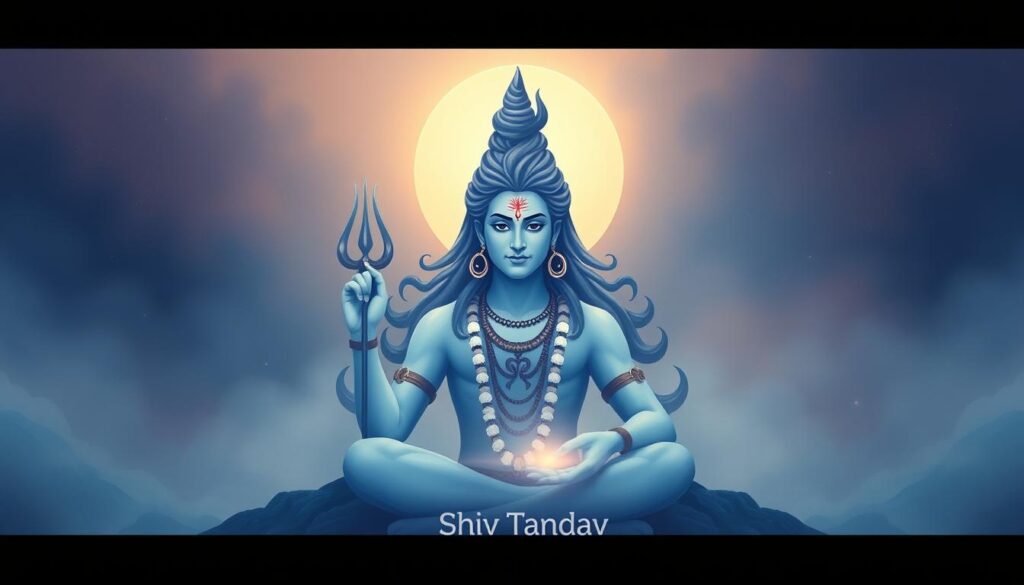
The sacred texts of Hinduism, like the Shiva Sahasranama, list thousands of names for Lord Shiva. These names, in ancient Sanskrit, show different sides of Shiva’s divine nature. Some well-known names include:
- Shiva (the pure one)
- Hara (the destroyer)
- Mṛḍa (the gracious one)
- Rudra (the terrible one)
- Maheśvara (the great lord)
- Nīlalohita (the blue-blooded one)
- Trilocana (the three-eyed one)
- Paśupati (the lord of beasts)
These names from ancient texts show Shiva’s many sides. They highlight his power, grace, and cosmic role. The variety of names shows the deep respect and mystery around Shiva in Hinduism.
“The thousand names of Shiva are a testament to the boundless divinity and complexity of this revered Hindu deity.”
The rich collection of Shiva’s names in sacred texts fascinates many. It offers a peek into Hindu philosophy and Shiva’s lasting impact.
The Significance of Mahadeva: The Great God
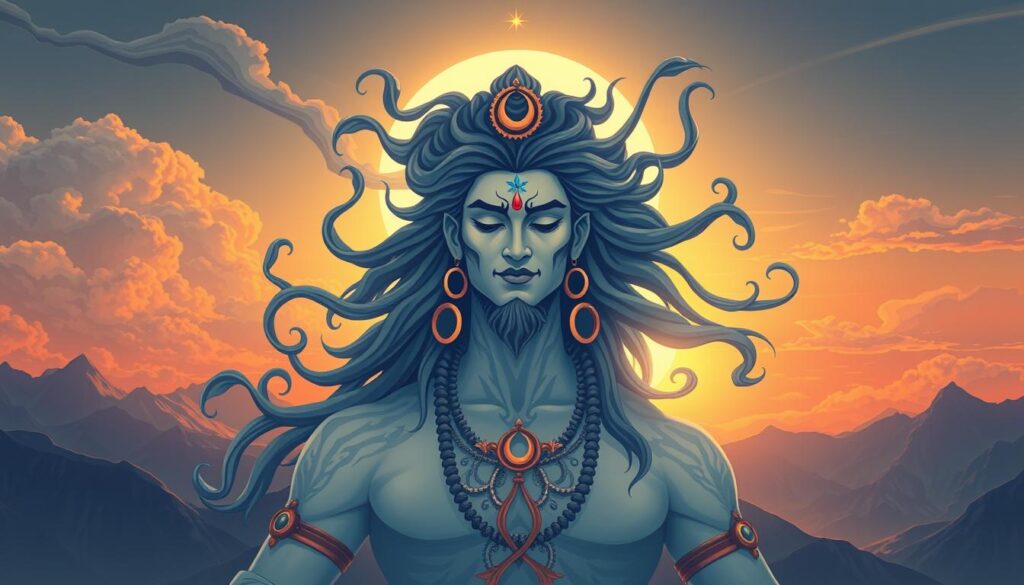
In Hinduism, Mahadeva, meaning “Great God,” is a key name for Lord Shiva. This title shows Shiva’s high status and his role as the master of all gods. As Shiva’s worship spread, Mahadeva became a symbol of his all-powerful and all-knowing nature.
Understanding the Title Mahadeva
Mahadeva is a complex term in Hinduism, mainly referring to Lord Shiva. He is seen as the supreme god, representing creation, preservation, and destruction. This title is found in many ancient Hindu texts, like the Puranas, Upanishads, and the Mahabharata and Ramayana.
Historical Context and Evolution
The title Mahadeva has deep roots in Hindu tradition. It dates back to before and during the Vedic era. As Shiva worship grew, so did the reverence for Mahadeva. It highlights Shiva’s power, immortality, and ability to grant wishes to his followers.
Synonyms for Mahadeva, like Shiva, Shankar, Bholenath, and Rudra, show Shiva’s varied roles in Hindu scriptures. The importance of Mahadeva goes beyond its literal meaning. It represents Shiva’s roles as the universe’s father, protector, and guide. His divine qualities and widespread presence in Hindu texts make him a revered deity, deserving of worship and devotion.
Sacred Names Related to Shiva’s Cosmic Dance
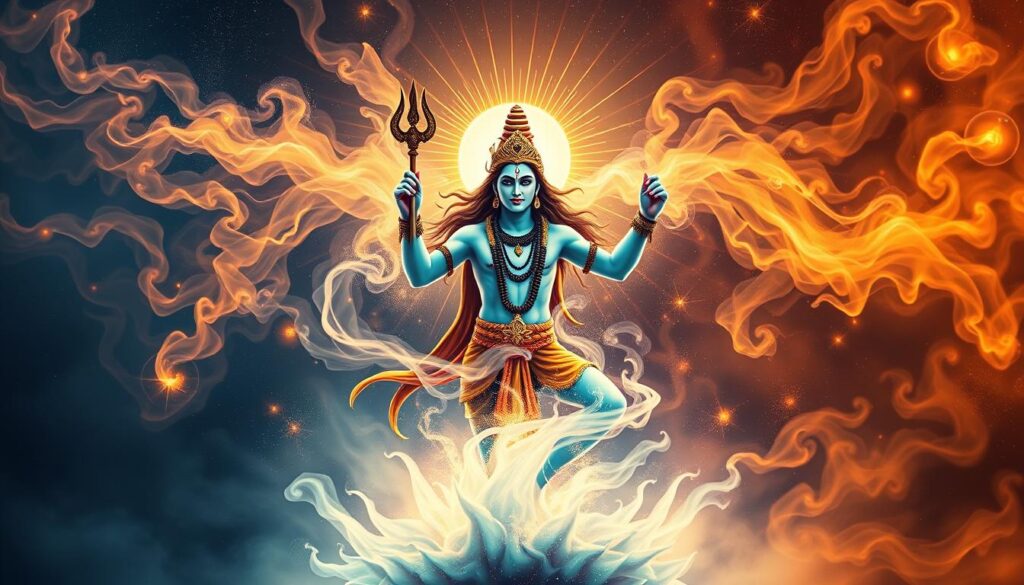
Lord Shiva, the revered Hindu god, is often seen as the Nataraja, or the “King of Dance.” This role shows his role in the cosmic dance that rules creation, preservation, and destruction. Shiva’s names tied to his dance are deeply spiritual and show his many sides.
The name Nataraja means “Lord of the Dance.” It shows Shiva’s skill in the cosmic dance, keeping the universe moving. Another name, Nṛtyapriya, means “the lover of dance.” It shows Shiva’s deep love for dance as a way to express the soul.
The name Lāsyapriya means “fond of the Lasya dance.” It talks about the gentle, feminine side of Shiva’s dance. The Lasya dance is linked to the divine feminine, like Shiva’s partner, Parvati. This name shows the balance between male and female in the divine.
These names of Shiva are full of meaning and spiritual depth. They help us understand Shiva’s role as the cosmic dancer. They show that Shiva’s dance is more than just movement. It’s a symbol of the universe’s eternal cycle of life and change.
Shiva’s Names as the Universal Destroyer
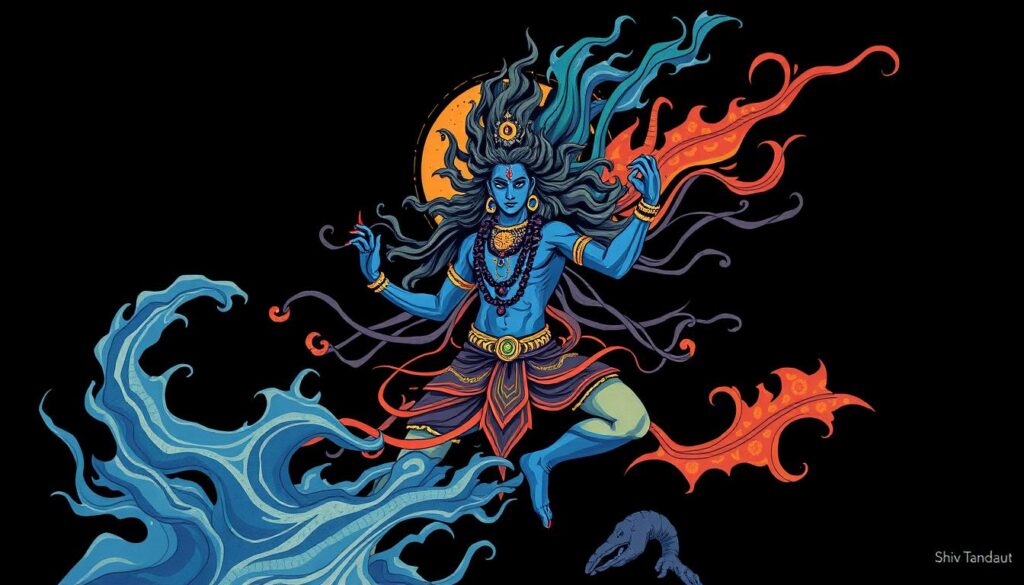
Lord Shiva is a key figure in Hindu mythology. He is seen as the creator, preserver, and destroyer. His names like Kāla (time/death), Rudra (the roarer), Bhairava (the terrible), and Saṃhāra (destroyer) show his destructive side.
These names highlight Shiva’s role in the cycle of life and death. He destroys old things to make way for new ones. This shows his power to change and move beyond the physical world.
Names Reflecting Destructive Aspects
- Kāla (Time/Death): Shiva as the personification of time, who ultimately claims all living beings.
- Rudra (The Roarer): Shiva’s fierce and formidable aspect, known for his destructive power.
- Bhairava (The Terrible): Shiva in his most terrifying form, associated with annihilation and punishment.
- Saṃhāra (Destroyer): Shiva as the one who initiates the process of destruction, clearing the way for new creation.
Symbolic Meanings Behind Destructor Names
These names show Shiva’s power to destroy and transform. He clears the way for spiritual growth and enlightenment. His destruction is seen as a necessary step for new life and growth.
“Shiva, the Destroyer, is not only the annihilator of the world, but also the regenerator, the transformer who opens the way for new forms of life and new stages of evolution.” – Ananda Coomaraswamy
Names Depicting Shiva’s Role as Supreme Yogi
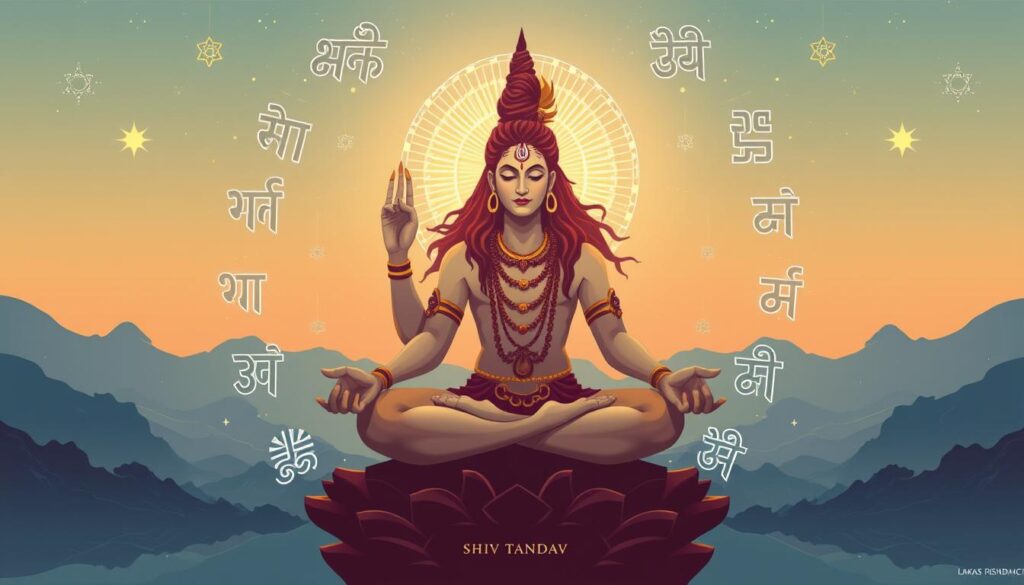
Lord Shiva is a revered Hindu deity known as the supreme yogi. He represents the highest spiritual achievements. His names show the deep spiritual meaning behind his divine persona.
These names highlight his connection to asceticism, meditation, and spiritual enlightenment.
Some key names that show Shiva’s role as the supreme yogi are:
- Mahāyogin (the great yogi)
- Yogeśvara (the lord of yoga)
- Dhyānādhāra (the support of meditation)
These names show Shiva’s mastery of yoga and his deep spiritual knowledge. He is seen as the first teacher of yoga, the Adiyogi.
| Name | Meaning |
|---|---|
| Mahāyogin | The great yogi, embodying the highest spiritual attainments |
| Yogeśvara | The lord of yoga, the supreme authority on the yogic path |
| Dhyānādhāra | The support of meditation, the foundation for spiritual enlightenment |
These names remind us of Shiva’s deep connection to yoga. They highlight the richness of Hindu spirituality. By understanding these names, devotees can connect more deeply with the divine.
Shiva’s Names in the Shiva Sahasranama
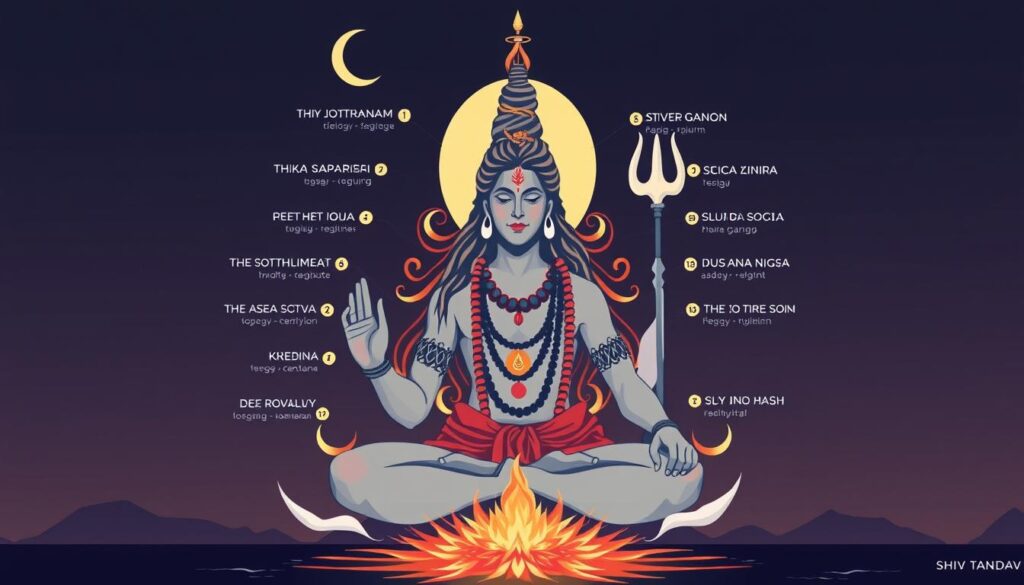
The Shiva Sahasranama is a sacred Hindu text found in the Mahabharata. It lists a thousand names that show the divine nature of Lord Shiva. These descriptive names of Shiva highlight the significance of Shiva’s names and the many sides of the destroyer god.
Understanding the Thousand Names
The Shiva Sahasranama Stotra hymn has 1008 names of Lord Shiva. These names are from the Shiva Purana – Koti Rudra Samhita and the Mahabharata. Each name shows a unique part of Shiva’s divine character, roles, and symbols in Hindu myths and beliefs.
Categories of Divine Names
- The names cover various aspects like purity, destruction, kindness, fear, nourishment, nobility, lordship, and more.
- Many names link Shiva to symbols like the moon, a skull, a bull, and a bow.
- Symbolism, myths, and cosmic references are common in the names. They connect Lord Shiva to the universe and its principles.
Each name in the Shiva Sahasranama starts with “Om”. It’s arranged in groups of 10 names per row. This shows the significance of Shiva’s names and the deep devotion to the destroyer god in Hinduism.
Regional Variations of Shiva’s Names
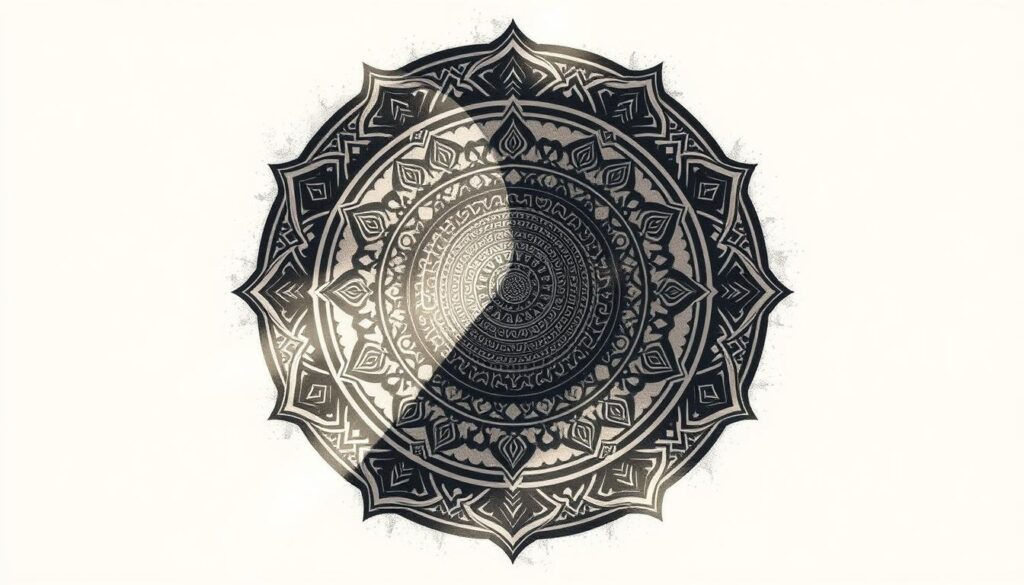
India’s rich cultural heritage has led to many names for Lord Shiva. People across the subcontinent honor the trimurti, a divine trio of Brahma, Vishnu, and Mahadev (Shiva). Each has its own identity and role.
In Maharashtra, Khandoba is seen as a form of Mahadev. He is celebrated as a protector and warrior. This shows the region’s unique cultural needs.
The Lingam, Shiva’s iconic symbol, has many meanings. In Maheshwar, the Narmada Linga is a sacred Linga. It attracts many devotees.
The Nataraj, Shiva as the cosmic dancer, varies by region. In Tamil Nadu, the Nataraj is known for its beauty. It shows Shiva’s role in destroying ignorance and keeping order.
In Uttarakhand, Shiva is known as Adiyogi, the first Guru and Yoga’s creator. The Adi Shankaracharya built a holy Shiva temple at Kedarnath.
These variations show India’s cultural diversity. They highlight the Mahadev‘s importance to many people across the subcontinent.
| Region | Regional Deity/Name | Significance |
|---|---|---|
| Maharashtra | Khandoba | A form of Shiva revered as a protector and warrior |
| Maheshwar | Narmada Linga | One of the most sacred Lingas in Hindu tradition |
| Tamil Nadu | Nataraj | The cosmic dancer form of Shiva, revered for its intricate and graceful depiction |
| Uttarakhand | Adiyogi | Shiva as the first Guru and the originator of Yoga |
The meaning of Shiva names and their variations show the Hindu faith’s richness. They reflect the Mahadev‘s complex nature and his lasting impact on India’s culture.
Names Associated with Shiva’s Divine Family
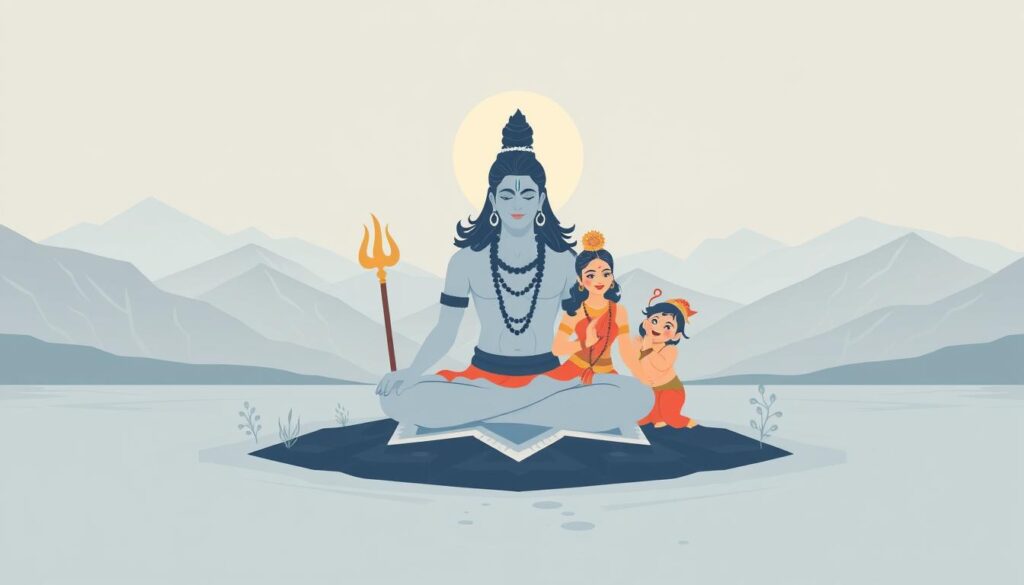
Lord Shiva’s family is key in Hindu theology. His names show his roles in this sacred group. He is Parvati’s husband and the father of Ganesha and Kartikeya. These roles are deeply honored and celebrated in Hindu tradition.
Shiva is often called Umāpati, meaning “lord of Uma” or “lord of Parvati.” He is also known as Gaurīśaṅkara, the “lord of Gauri,” another name for Parvati. These names show Shiva’s role as a divine husband and the balance in the Shiva-Shakti relationship.
As a father, Shiva is named Gaṇeśvara, the “lord of Ganesha.” He is also called Kumārapitā, meaning “father of Kumara,” or Kartikeya. These names show Shiva as the father of these important deities in Hindu pantheon.
| Shiva’s Family Name | Meaning |
|---|---|
| Umāpati | Lord of Uma/Parvati |
| Gaurīśaṅkara | Lord of Gauri |
| Gaṇeśvara | Lord of Ganesha |
| Kumārapitā | Father of Kumara/Kartikeya |
These names show Shiva’s roles as a husband, father, and key member of the Hindu pantheon. They highlight the importance of family and the connections between deities in Hindu theology.
Shiva’s Names in Ancient Temple Inscriptions

Ancient temple inscriptions give us a peek into the many names and titles for Lord Shiva. They show us the varied ways people have honored him over time. This helps us understand the rich tapestry of beliefs and practices that have shaped our view of Shiva.
Researchers have looked into lesser-known temples in places like Maharashtra’s Pune district. They found unique symbols, rituals, and stories linked to Shiva. For example, the late medieval Bengal temple Jor-Bangla Gangeshwar Shiva offers insights into the complex relationships between those who built temples and the communities they served.
It’s fascinating to learn that Shiva is often named 108 times in these inscriptions. This number is sacred in Hindu tradition, tied to the body’s energy centers. Chanting these names is thought to connect us deeply with the divine, helping us grow spiritually and find inner peace.
| Temple | Region | Unique Shiva Names |
|---|---|---|
| Jor-Bangla Gangeshwar Shiva | Murshidabad, Bengal | Gangeshwar, Mahananda, Sukhbindu |
| Shiva-Buddhist Temples | Singhasari-Majapahit, Indonesia | Mahadeva, Yogiswara, Bhairava |
| Shiva Temples in Pune | Maharashtra, India | Mallikarjuna, Kailashnath, Trinetra |
Studying these ancient inscriptions deepens our knowledge of hindu god shiva’s names. It also highlights the cultural and religious diversity that has influenced Shiva worship. By exploring shiva’s many names and their meanings, we appreciate the exploring shiva’s divine names more deeply. This enriches our understanding of Hindu spirituality.
Modern Interpretations of Shiva’s Names

Shiva’s names have always fascinated people. They explore the deep meanings and symbols behind these ancient words. Today, these names help us understand Shiva’s complex nature, guiding us on our spiritual journey.
Contemporary Understanding
Shiva’s names hold deep spiritual meaning. They connect us to the universe and our own inner peace. These names help us grow by teaching us about detachment and balance.
Shiva’s names show his power to unite opposites. They remind us of his role in creation, preservation, and change.
Cultural Impact
Shiva’s names are everywhere in Indian culture. They appear in songs, texts, and rituals. They help us feel connected to the divine.
Many people choose Shiva’s names for themselves. This shows how much he influences Indian culture and spirituality. Shiva’s names continue to inspire art and thought in India.
“Shiva’s names are not just names. They are a guide to the universe and our own souls. They help us understand our place in the world.”
| Shiva Form | Shiva Attribute | Shiva Meaning | Shiva Symbolism | Shiva Devotion |
|---|---|---|---|---|
| Nataraja | Cosmic Dancer | Lord of the Dance | Represents the dynamic interplay of creation, preservation, and destruction | Epitomizes the union of the divine and the human, invoking grace, power, and transcendence |
| Ardhanarishvara | Androgynous Form | Half-woman, Half-man | Symbolizes the integration of masculine and feminine principles, the yin and yang of the universe | Highlights the divine balance and complementarity of genders, inspiring inclusivity and harmony |
| Tripurari | Destroyer of the Three Cities | Conqueror of the Three Worlds | Signifies the annihilation of the three realms of desire, action, and knowledge, leading to spiritual liberation | Invokes the power to transcend the limitations of the material world and attain enlightenment |
Conclusion
The many Sanskrit names and titles of Lord Shiva give us a deep look into his divine nature. He is seen as part of the Hindu trinity and as a yogi, destroyer, and cosmic dancer. These names show the depth of his mythology and spiritual importance.
Exploring the meanings behind Shiva’s names shows his complexity. His titles like Mahadeva, the Great God, highlight his cosmic role. Chanting his 108 or 1008 names helps devotees purify, strengthen, and connect with Shiva’s universal essence.
Looking into Shiva’s names proves the richness of Hindu shiva worship, shiva avataras, shiva purana, shiva tandava, shiva family, and shiva legends. It shows Shiva’s lasting impact on India’s spirituality and culture.
FAQ
What is the full name of Lord Shiva?
Lord Shiva is also known as Mahadeva. He has many names in Sanskrit literature. These names show his different sides and divine nature.
What are some of the primary names and titles of Lord Shiva?
Shiva’s main names include Shiva (pure) and Hara (destroyer). He is also known as Mṛḍa (gracious) and Rudra (terrible). Other names are Maheśvara (great lord), Nīlalohita (blue-blooded), and Trilocana (three-eyed). He is also called Paśupati (lord of beasts).
What is the significance of the title “Mahadeva” for Lord Shiva?
Mahadeva means “Great God.” It’s a key title for Shiva. It shows his high status in Shaivism and his role as the lord of all gods.
What are the names related to Shiva’s cosmic dance?
Names like Nataraja (king of dance) and Nṛtyapriya (lover of dance) show Shiva’s cosmic dance. Lāsyapriya (fond of Lasya dance) also highlights his role as the cosmic dancer.
How are Shiva’s destructive aspects represented in his names?
Names like Kāla (time/death) and Rudra (the roarer) show Shiva’s destructive side. Bhairava (the terrible) and Saṃhāra (destroyer) also symbolize his role in creation and destruction.
What are some of the names depicting Shiva as the supreme yogi?
Names like Mahāyogin (great yogi) and Yogeśvara (lord of yoga) show Shiva as the supreme yogi. Dhyānādhāra (support of meditation) also emphasizes his connection to asceticism and meditation.
Where can we find the comprehensive list of Shiva’s names?
The Shiva Sahasranama in texts like the Mahabharata lists a thousand names of Shiva. These names are based on his attributes, roles, and forms.
How do regional variations influence Shiva’s names and epithets?
In India and South Asia, Shiva’s names vary by region. Each area highlights different aspects of Shiva, leading to unique names and epithets.
How do Shiva’s names relate to his divine family?
Names like Umāpati (lord of Uma/Parvati) and Gaurīśaṅkara (lord of Gauri) show Shiva’s family ties. Gaṇeśvara (lord of Ganesha) and Kumārapitā (father of Kumara/Kartikeya) also highlight his roles as a husband and father.
How do ancient temple inscriptions provide insights into Shiva’s names?
Ancient temple inscriptions offer unique insights into Shiva’s names. They show local variations and combinations of his names, reflecting regional beliefs and practices.
